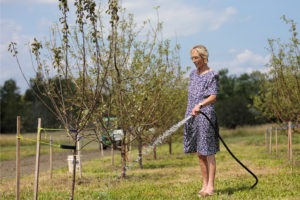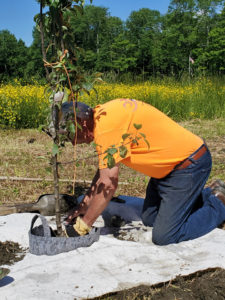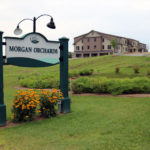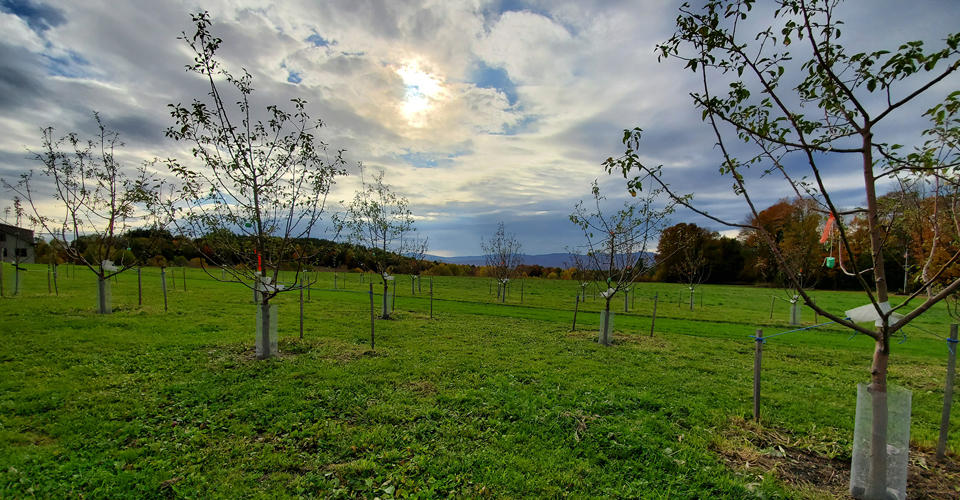
Twenty-one apple trees were planted in the summer of 2019 and their first harvest is expected in three-four years.
You can’t have Morgan Orchards without an orchard. And since we opened nearly three years ago, it’s the one big thing that’s been missing from our campus.
But creating an apple orchard has always been about more than living up to our name. It’s about honoring the history of our rural Vermont landscape, one that’s rooted in agriculturally rich soil. And by developing an orchard we not only enhance our property from a landscaping perspective but eventually provide healthy, locally-grown food for our residents to enjoy.
The half-dozen or so residents who brought this project to life agree.
“It makes a lovely statement, in spring there’s nothing lovelier,” says Vance Smith who’s been a champion of the orchard from the beginning and was involved in its design and development including selecting the location and developing the overall site plan. “An orchard reinforces the locavore movement of ‘we eat what we plant.’ And the path through the trees invites a walk for enjoyment. It gives me pride in our accomplishment.”
And it’s a wonderful achievement. But during the process residents learned that planning an apple orchard was no easy feat. A fact they discovered with their very first hurdle – determining which type of apples they wanted to grow. Within the United States alone there are more than 2,500 varieties of apple trees, and more than 150 of them are traditionally grown in Vermont.
It was Lori Holm who volunteered for the daunting task of researching the types of apple trees to determine which would fare the best in Vermont’s climate and our local geography.
Eventually, he narrowed the list down to thirty-five. But in the end, the residents agreed on planting just three: a sweet, yet sharp Honeycrisp, a great apple for butter, crisps, pies, and sauces; a crisp, juicy Liberty, an all-around great dessert apple that’s ideal for baking; and a Macoun, an extra sweet, but mild apple that’s perfect as a snack or added to salads.
Once the trees were selected, Holm set to work creating a planting grid to ensure the trees were planted at just the right distance from each other for optimal pollination and Gifford’s Vice President of Support Services, Doug Pfohl, began working to acquire the trees.
Twenty-one young saplings arrived in early summer. But heavy rains delayed permanently placing them for several weeks. They finally went into the dirt on the north side of Strode Independent Living in mid-summer, in an area that’s been designated as agricultural land. Planted in two rows, the saplings flank part of the walking trails. As they grow they’ll provide not only delicious fruit but lovely shade for those out enjoying a stroll on the grounds.
Since their arrival on-site, our dedicated team of residents has taken to tending the trees, some pruning, trimming, and staking, others putting up screening or watering. The trees even received a checkup from a member of neighboring VTC’s Agricultural Department. And all received a clean bill of health.
With the trees now in their new home, all attention has turned to ensuring they remain healthy so they can nourish not only our residents but our ties to the land.
As Bobbie Randall remarked, “The orchard adds to the rural, agricultural environment.”
A sentiment her husband, Forrest, shares.
“The orchard is part of the total grounds landscaping and provides a scenic area to walk through and observe the changes that occur as the seasons’ change, from dormancy to blossoming to bearing fruit… the marvel of nature in action,” commented Forrest, who was one of the many residents who had a hand in establishing the orchard. For his part, he helped with the pruning, screened the trunks to prevent rodent damage, and even hung bars of Irish Spring soap (purchased by Bobbie) to keep the deer from eating the buds.
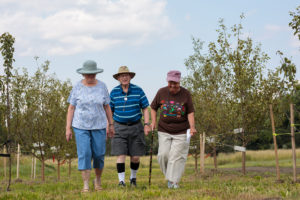
As they mature, the trees in the orchard will not only offer residents delicious produce but a beautiful shaded path to stroll through as they walk the grounds.
As spring bloomed all around Vermont, so did the apple trees, their branches sprouting tiny blossoms. And while the trees have begun to bud, all of our residents are anxiously anticipating the very first harvest, which should be in three to four years.
But this fabulous addition to our landscape wouldn’t have been possible without our passionate and dedicated residents who brought it to life.
This is the final article in this four-part series on the development of the Morgan Orchards landscape.
Read the other articles in this series:

